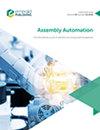Planning and optimization of robotic pick-and-place operations in highly constrained industrial environments
IF 1.7
4区 计算机科学
Q3 AUTOMATION & CONTROL SYSTEMS
引用次数: 5
Abstract
Purpose The purpose of this paper is to give a comprehensive solution method for the manipulation of parts with complex geometries arriving in bulk into a robotic assembly cell. As bin-picking applications are still not reliable in intricate workcells, first, the problem is transformed to a semi-structured pick-and-place application, then by collecting and organizing the required process planning steps, a methodology is formed to achieve reliable factory applications even in crowded assembly cell environments. Design/methodology/approach The process planning steps are separated into offline precomputation and online planning. The offline phase focuses on preparing the operation and reducing the online computational burdens. During the online phase, the parts laying in a semi-structured arrangement are first recognized and localized based on their stable equilibrium using two-dimensional vision. Then, the picking sequence and corresponding collision-free robot trajectories are planned and optimized. Findings The proposed method was evaluated in a geometrically complex experimental workcell, where it ensured precise, collision-free operation. Moreover, the applied planning processes could significantly reduce the execution time compared to heuristic approaches. Research limitations/implications The methodology can be further generalized by considering multiple part types and grasping modes. Additionally, the automation of grasp planning and the enhancement of part localization, sequence planning and path smoothing with more advanced solutions are further research directions. Originality/value The paper proposes a novel methodology that combines geometrical computations, image processing and combinatorial optimization, adapted to the requirements of flexible pick-and-place applications. The methodology covers each required planning step to reach reliable and more efficient operation.高度受限工业环境中机器人取放操作的规划和优化
目的本文的目的是给出一种复杂几何形状零件批量到达机器人装配单元的综合求解方法。由于垃圾箱拾取应用程序在复杂的工作单元中仍然不可靠,首先,将问题转换为半结构化的拾取和放置应用程序,然后通过收集和组织所需的过程规划步骤,形成一种方法,即使在拥挤的装配单元环境中也能实现可靠的工厂应用程序。设计/方法/方法工艺规划步骤分为离线预计算和在线规划。离线阶段侧重于准备操作和减少在线计算负担。在在线阶段,首先利用二维视觉识别半结构化排列的零件,并根据零件的稳定平衡定位零件。然后,对拾取顺序和相应的无碰撞机器人轨迹进行规划和优化。所提出的方法在几何复杂的实验工作单元中进行了评估,确保了精确、无碰撞的操作。此外,与启发式方法相比,应用规划过程可以显著减少执行时间。研究的局限性/启示:该方法可以通过考虑多种零件类型和抓取方式来进一步推广。此外,用更先进的解决方案实现抓具规划的自动化,增强零件定位、序列规划和路径平滑是进一步研究的方向。本文提出了一种结合几何计算、图像处理和组合优化的新方法,以适应灵活取放应用的要求。该方法涵盖了每个必要的规划步骤,以达到可靠和更有效的操作。
本文章由计算机程序翻译,如有差异,请以英文原文为准。
求助全文
约1分钟内获得全文
求助全文
来源期刊

Assembly Automation
工程技术-工程:制造
CiteScore
4.30
自引率
14.30%
发文量
51
审稿时长
3.3 months
期刊介绍:
Assembly Automation publishes peer reviewed research articles, technology reviews and specially commissioned case studies. Each issue includes high quality content covering all aspects of assembly technology and automation, and reflecting the most interesting and strategically important research and development activities from around the world. Because of this, readers can stay at the very forefront of industry developments.
All research articles undergo rigorous double-blind peer review, and the journal’s policy of not publishing work that has only been tested in simulation means that only the very best and most practical research articles are included. This ensures that the material that is published has real relevance and value for commercial manufacturing and research organizations.
 求助内容:
求助内容: 应助结果提醒方式:
应助结果提醒方式:


